Overall Scope of the Problem
- 15.2 million of Americans are alcohol-dependent:
- 3.9 million are exclusively illicit drug users;
- 58.1 million of Americans of 12 years of age or older joined a binge drinking session at least once a month before the study;
- 17.3 million of Americans were self-reported heavy drinkers:
- 20.1 million of Americans subscribe to the usage of a hard drug;
- 2,300 out of substance abuse treatment facilities are reported redundant;
- (Substance Abuse and Mental Health Services Administration, 2009a).
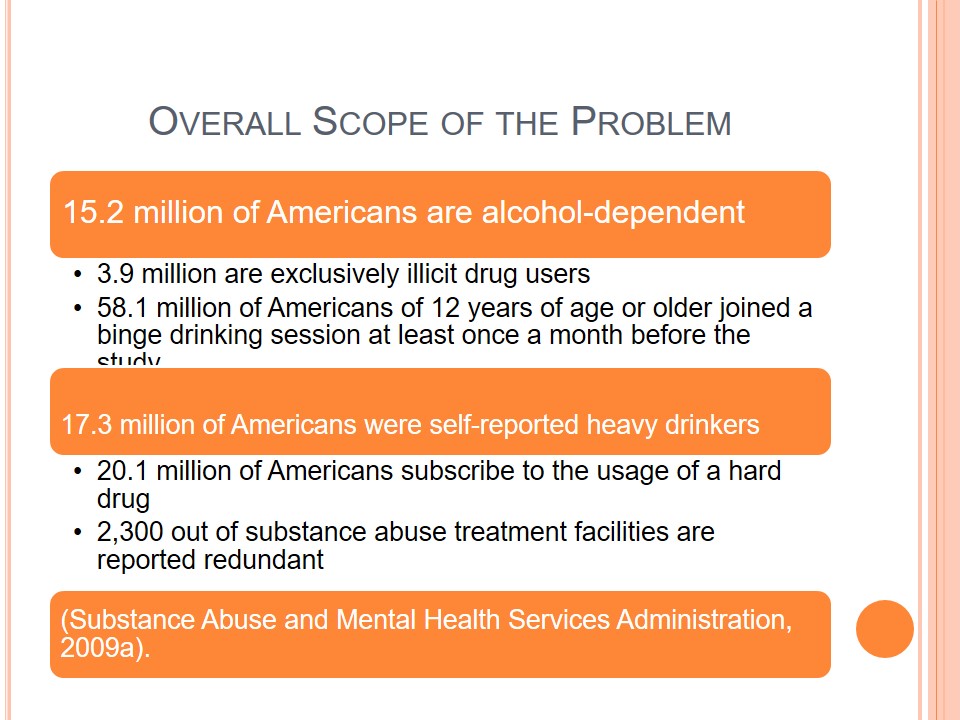
Detoxification Stages
- Assessment and Evaluation.
- Stabilization or Actual Detoxification.
- Transition to Rehabilitation or Other Treatment.
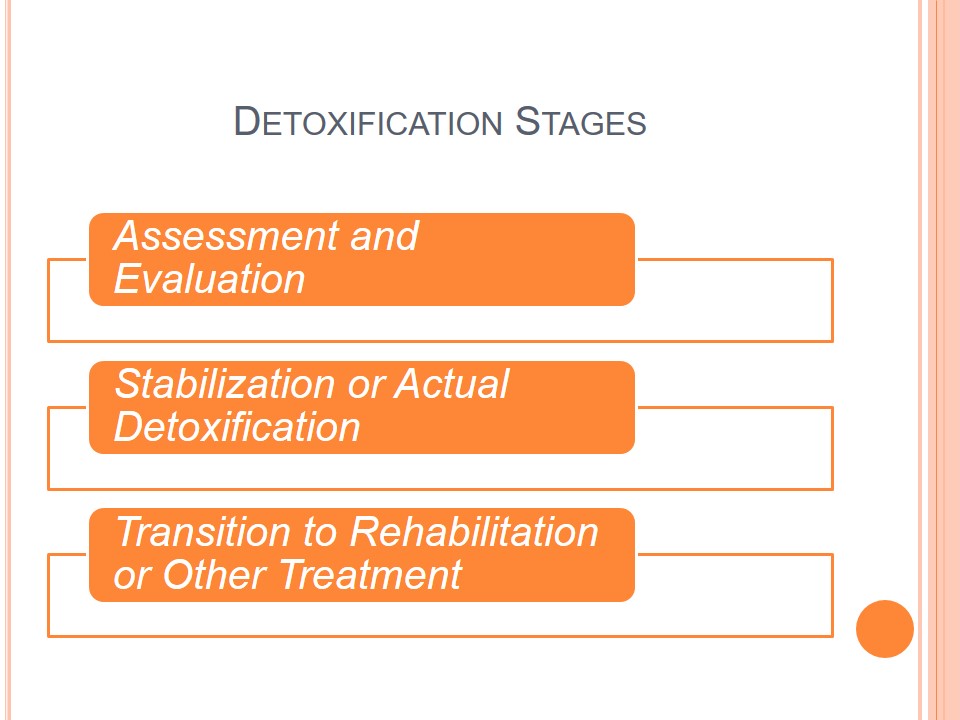
Literature Review
- Nature of withdrawal (Collins et al., 2005).
- Medication-assisted treatment.
- Non-pharmacological therapies (Krampe, Stawicki & Wagner, 2006).
- Mitigating the pain of drug withdrawal with rapid detoxification (Teplin et al., 2005; Ries et al., 2009).
- Choice criteria for withdrawal medications (benzodiazepines, buprenorphine).
- Advantages of benzodiazepines:
- Help in the control of agitation and the management of seizures associated with withdrawal.
- Help in the prevention of delirium tremens.
- They act as cross-tolerant agents with alcohol.
- Choice criteria in favor of benzodiazepines:
- Route of administration.
- Pharmacokinetic characteristics.
- Protocols of treatment.
- High dosage and tapering.
- Fixed dose/loading regimen etc.
- Unwanted conditions of benzodiazepine usage:
- Patients reported uncontrolled usage of benzodiazepines to get ‘high’.
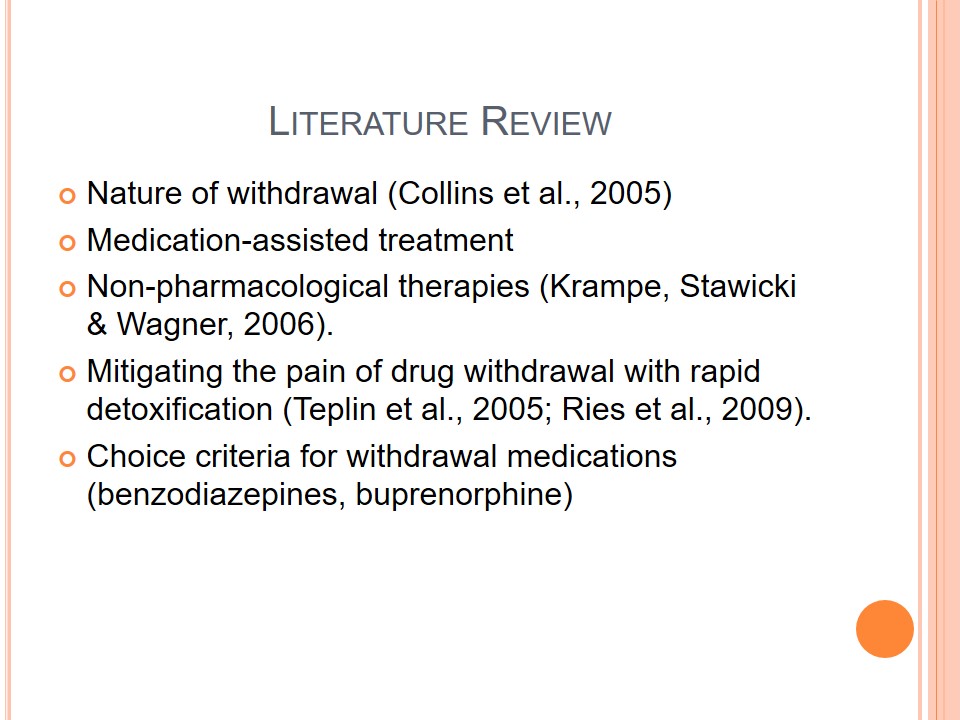
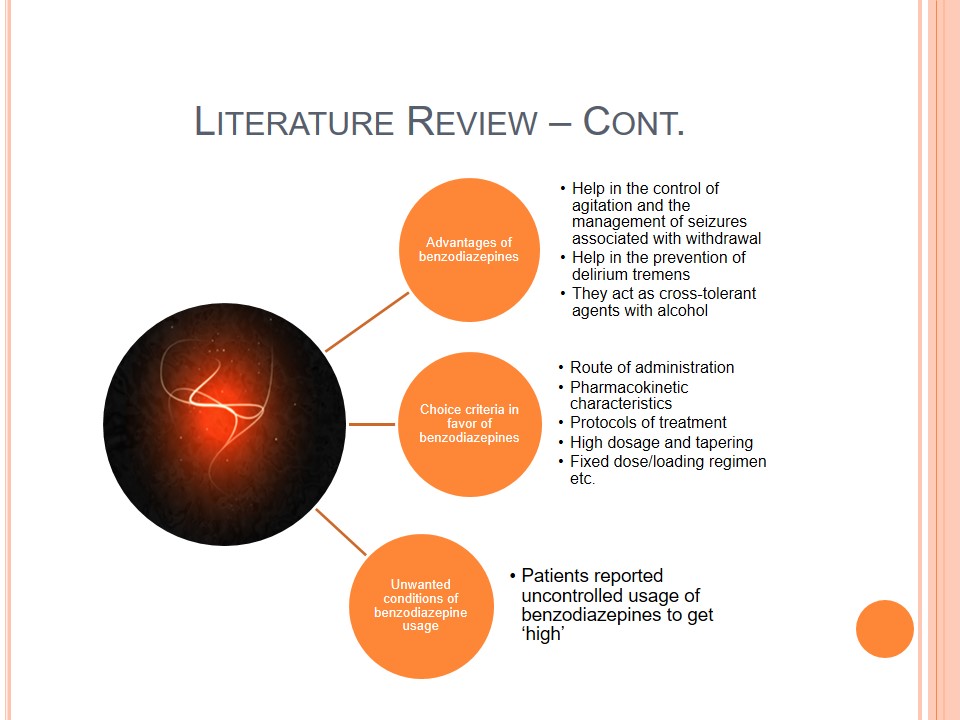
Rationale for the Project
- Benchmark criteria:
- Behavioral.
- Graduated.
- Cost effectiveness.
- Health status.
- Marketing & Sales.
- Limitations:
- Reliability and projectibility of the evaluation results apply solely to the cohort of patients who had undergone detoxification at Sunrise.
- The ability to reach and re-contact patients within the period of four weeks to 12 months after they leave Sunrise.
- Prospective benefits:
- Information can be used to educate the patients and give them an informed option to choose.
- Although expensive, the long term benefits of the Sunrise program may make it a preferred option.
- Information for on-going evaluation of the efficiency of their team will be derived.
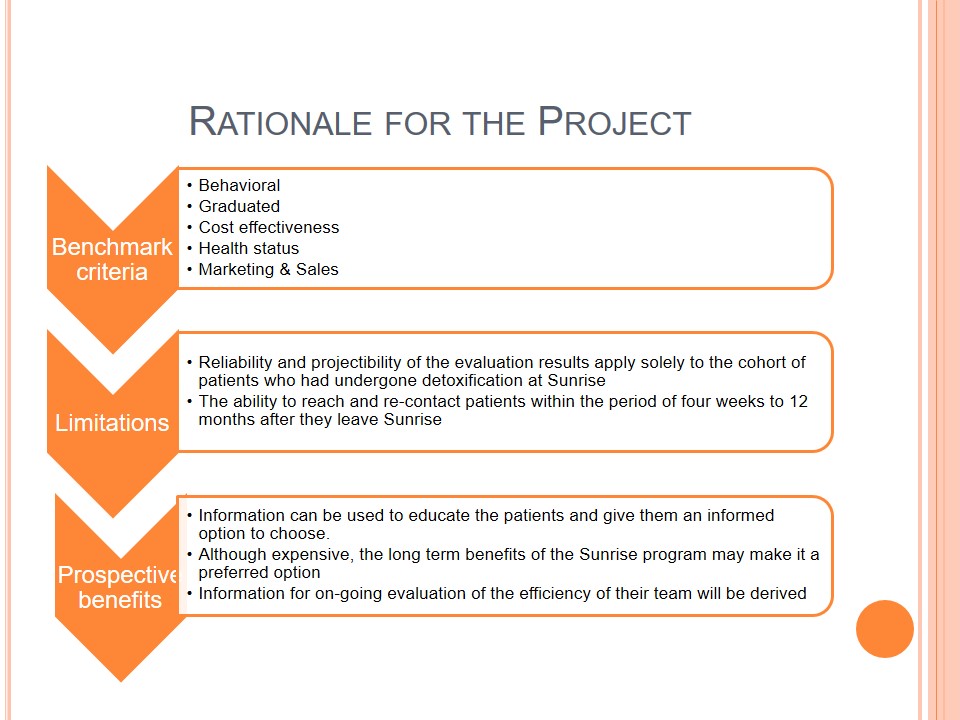
Location and Function of Location
- Sunrise is an upscale privately-owned detoxification center treating 20-30 clients at any given time.
- Patients stay from four to 14 days depending on substances, are voluntarily admitted and some co-occurring addictions discovered at the time of admission.
- When the patient has crossed the hurdle of pain and symptoms associated with withdrawal, he/she proceeds to either institutional or community-based rehabilitation.

Project
- The process starts with an assessment of in-house outcomes in the detoxification center, tracks patients who have gone to rehabilitation and elicits self-reports on being substance free in the short and medium term;
- The internal evaluation is a two-track assessment of detoxification outcomes for alcohol and opiate abuse patients;
- The intermediate outcome will be assessed as a 4-week benchmark;
- The long-term result will be assessed as a 12-week benchmark.
Successful detoxification is the main valuable achievement (in case all indicators are stable, the following variables will indicate the success):
- Prior history of dependence relapses;
- Type of medication administered;
- Participation in group therapy during the critical stabilization and recovery stages at the detoxification center;
- Quality of social support and domestic/family life.
The purpose of this project: to establish establish whether the detoxification facility is an important inclusion in the process of getting addicts off drugs.
The proposed project design will test for the strength of the relationship between the several patient/treatment factors and successful withdrawal/recovery.
The project design includes all ethical considerations (informed consent of patients, approval of the university Ethics Committee etc.).
The project will advance scholarly findings in the field of detoxification programs and their effectiveness.
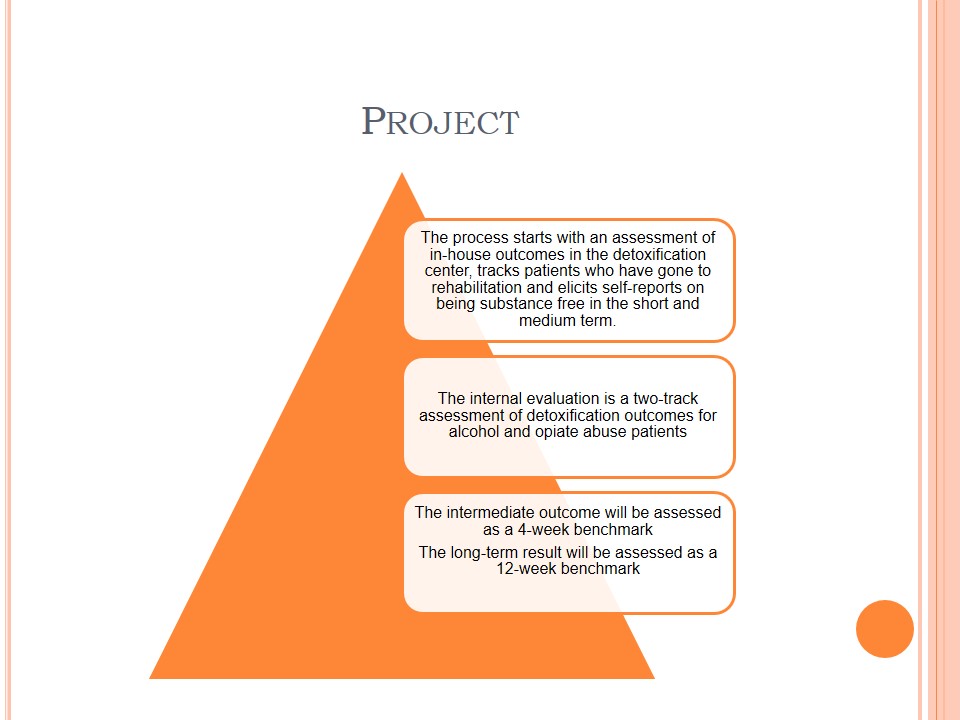
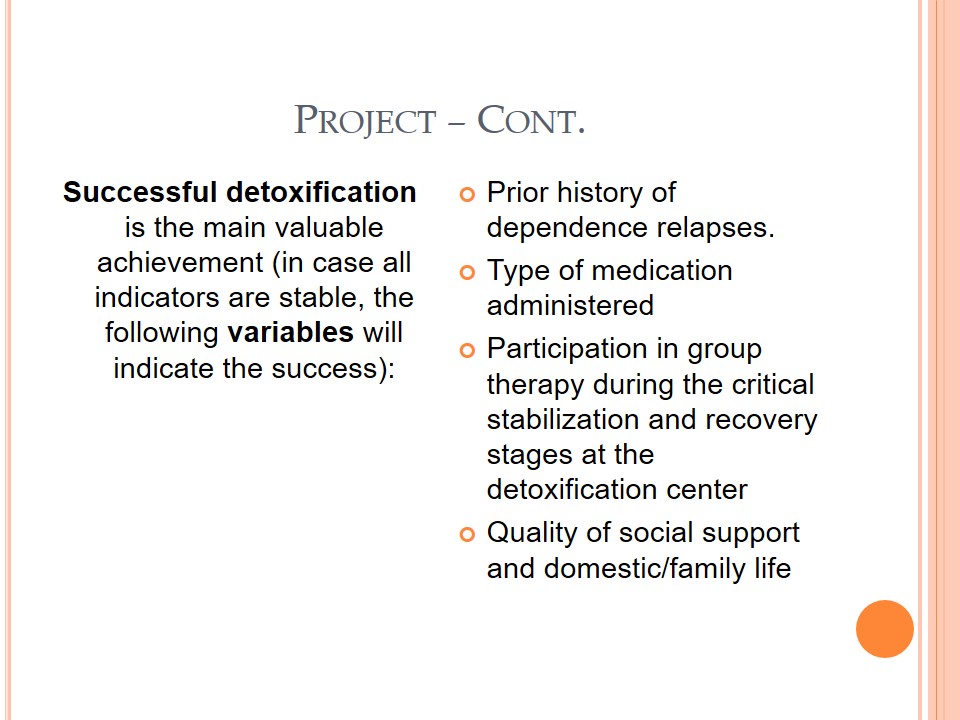
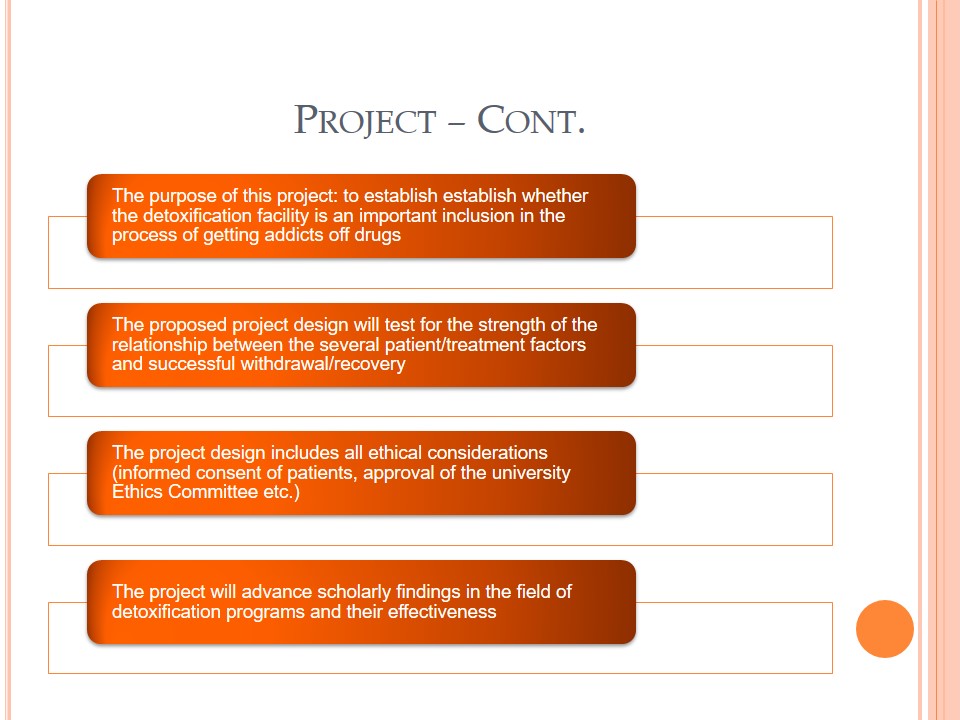
Impact of Project (Advantages of Approach)
Reliability and consistency of the data since these have to be recorded under the guidance of center staff at the time of admission.
Time effectiveness for data collection and fieldwork. Familiarity with, and a presumably favorable image of, the treatment facility predisposes previous patients to cooperate fully when re-contacted about their drug- or alcohol-free status from four weeks to 12 months post detoxification.
By embarking on an evidence-based investigation of both major components in the treatment regimen, the evaluator effectively implements a program study. At the end of the project, one is in a position to present an analysis and offer rigorous recommendations based on evidence-based inquiry techniques. This is a study that reviews patient records to find relationships among the critical success factors.
The findings of this capstone project have the potential for modifying “best practices” at Sunrise Detox II if it can be shown that long-term relapse rates are sub-par compared to the national benchmarks reported by SAMHSA.
The medication under review will be benzodiazepine and buprenorphine.
This strategy, will in effect, go a long way in enhancing evidence based practice.


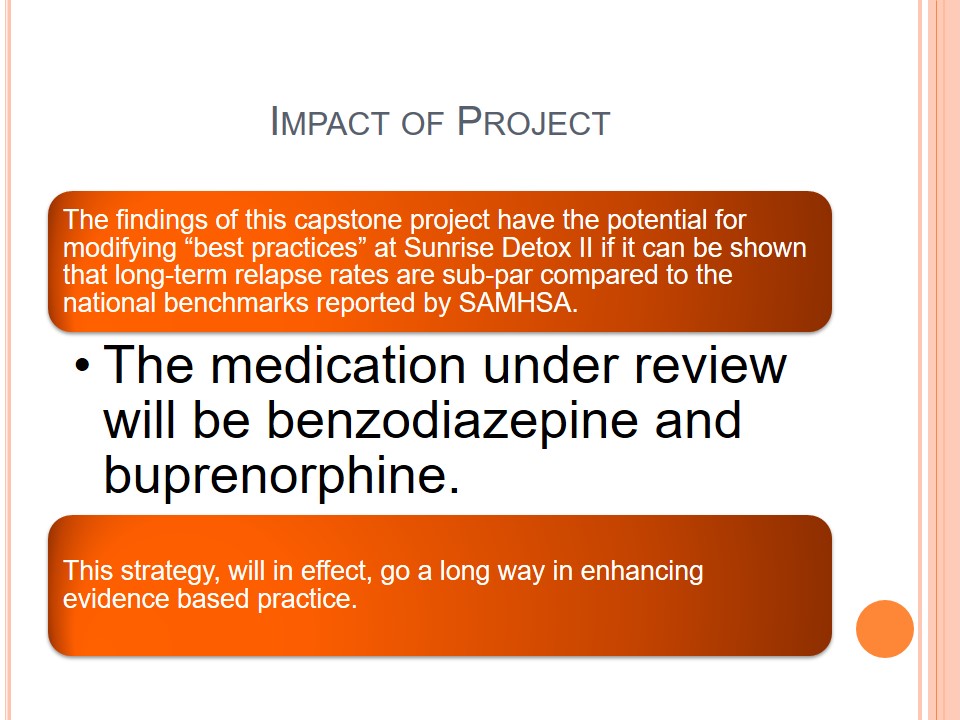
How Will Results Be Presented?
On arrival at the center, clinical staff fill in the Clinical Institute Withdrawal Assessment of Alcohol Scale, Revised (CIWA-R) for alcohol dependents or the Clinical Opiate Withdrawal Scale (COWS) for those dependent on illicit drugs:
- History of relapse.
- Domestic situation/ Family life.
- Social networks.
The admitting orders form with a prepared checklist of medications to assist with the withdrawal and recovery phases will be used as a tool for presenting data.
Step 1:
The evaluator will randomly draw a total of 100 alcohol dependent and 100 opiate dependent patients from Center patient files going back about five years.
Step 2:
All patient records with either the CIWS or COWS forms (or both) filled out will be extracted from the center database, checked to see which patient and withdrawal medication classification they belong to and listed as part of the project sampling frame.
Nota Bene:
If the number exceeds the quota of 200, systematic sampling will be carried out to arrive at a final list of patient records.
Two hundred patients in a sample would provide effective data collection and at the same time ensure that the information is as close as possible to the information in the general public.
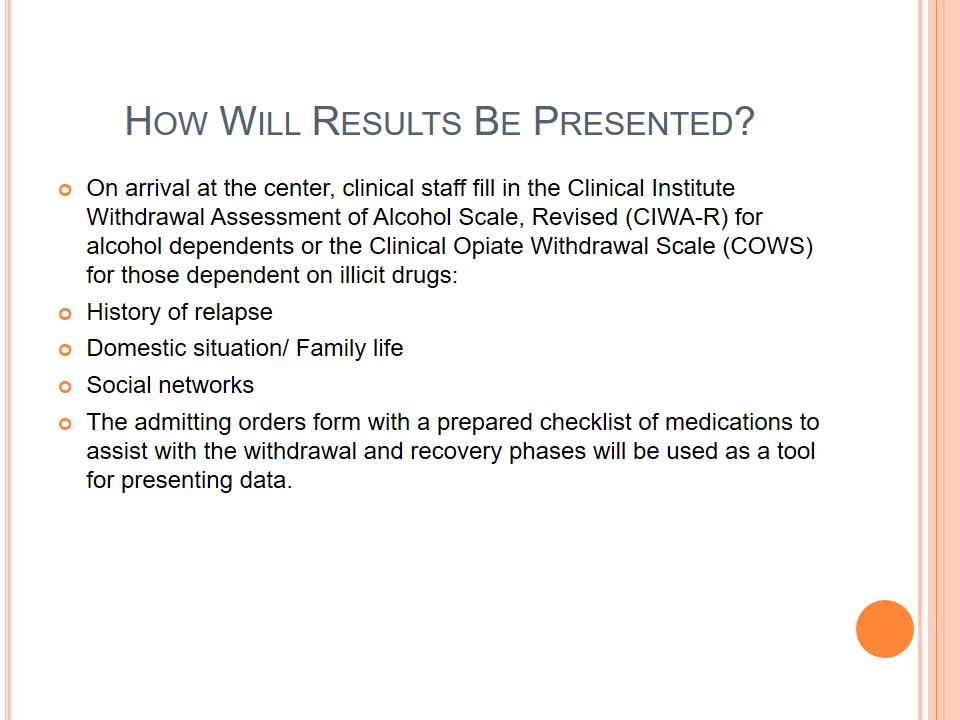
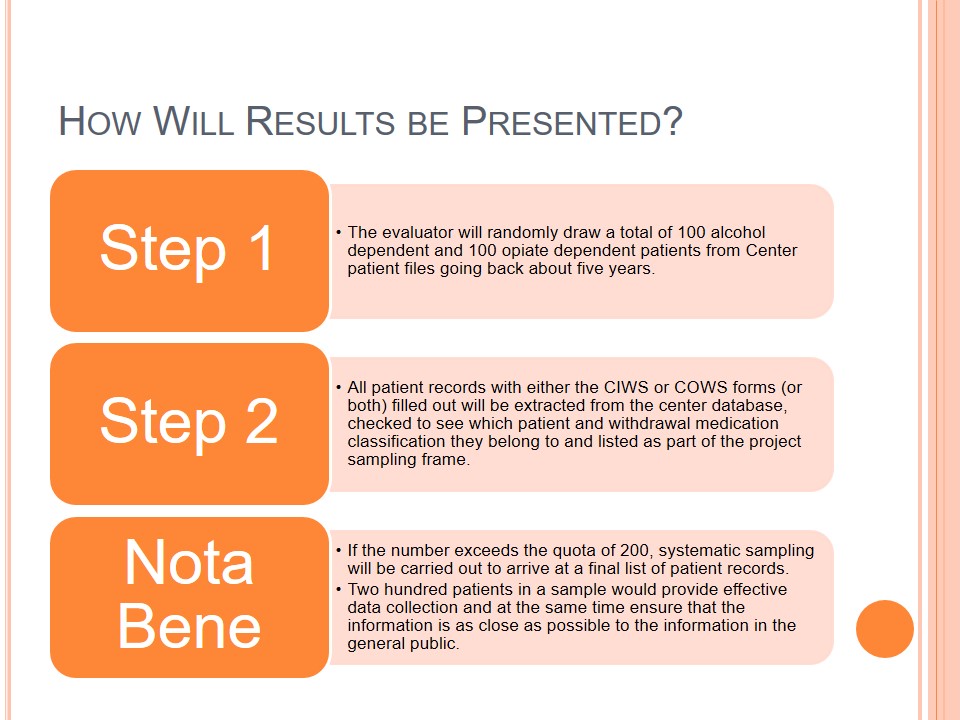
References
- Collins, E. D., Kleber, H.D., Whittington, R. A., & Heitler, N. E. (2005). Anesthesia-assisted vs buprenorphine- or clonidine-assisted heroin detoxification and naltrexone induction: A randomized trial. JAMA, 294 (8): 903–13.
- Cohen, L.M. (2008). Pharmacology and Treatment of Substance Abuse: Evidence and Outcome Based Perspectives. United States: CRC Press.
- Substance Abuse and Mental Health Services Administration. (2009a). Results from the 2008 National Survey on Drug Use and Health: National Findings. (Office of Applied Studies, NSDUH Series H-36, HHS Publication No. SMA 09-4434). Rockville, MD.
- Ducharme L. J. & Luckey, J. W. (2000). Implementation of the methadone treatment quality assurance system: Findings from the feasibility study. Evaluation & Health Professions, 23 (1): 72–90.
- Jung, R.J., Jung, J., (2009). Alcohol, Other Drugs, and Behavior: Psychological Research Perspectives. Los Angeles: Sage.
- Krampe, H., Stawicki, S., & Wagner, T. (2006). Follow-up of 180 alcoholic patients for up to 7 years after outpatient treatment: Impact of alcohol deterrents on outcome. Alcoholism, Clinical and Experimental Research, 30 (1): 86–95.
- Lawrence, M. V. (2010). What is an alcohol addiction detox? Web.
- Ries, R.K., Miller, S., Fiellin, D.A., & Saitz, R. (2009). Principles of Addiction Medicine. Philadelphia: Lippincott Williams & Wilkins.
- Robotham, J. (2005). The great divide over detox. Web.
- Teplin, D. Raz, B. Daiter, J., Varenbut, M., Zachos, C. T., Whang, P., Herman, S., Chaudry, S. and Yung, M. (2005). Measurement of symptom withdrawal severity in a 24-hour period after the anesthesia-assisted rapid opiate detoxification procedure. American Journal of Drug and Alcohol Abuse, 31(2):327-335.
- U.S Department of Health and Human Services (2006). Detoxification and substance abuse treatment. pp. 4–5. Web.
- Yates, B. T. (2005). Measuring and improving costs, cost-effectiveness, and cost-benefit for substance abuse treatment programs: A manual. Washington, DC: National Institute on Drug Abuse.